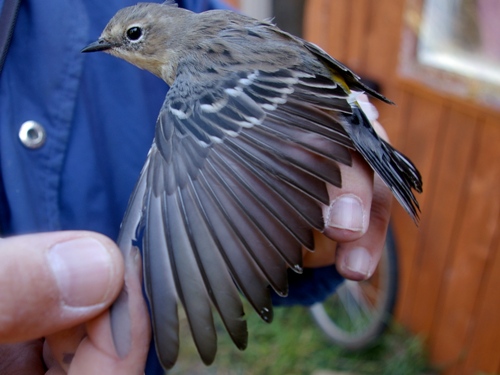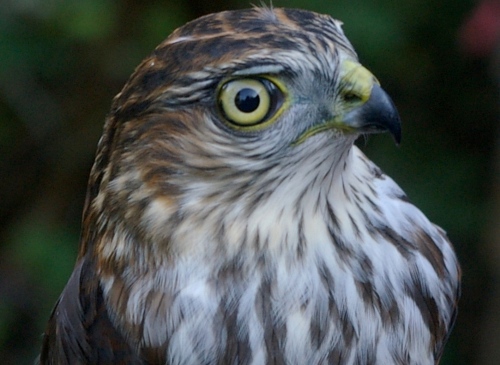|
Week 7: September 12-18, 2008 |
Welcome
to the McGill Bird Observatory weekly report.
Click here for a complete listing of our archives.
Comments or
questions are welcome at "mbo AT migrationresearch.org".
|
PICTURE
OF THE WEEK: |
|

A sure sign of the advancing season was the arrival of Yellow-rumped Warblers this week.
This hatch-year male shows a distinct contrast between the dull brownish primary coverts,
primaries, and secondaries of the wing, relative to the darker and fresher greater coverts.
(Photo by James Junda)
|
|
|
THIS WEEK |
THIS FALL |
2008 TOTAL |
SITE TOTAL |
|
# birds (and species) banded |
203 (35) |
1511 (66) |
2353 (79) |
15331 (105) |
|
# birds (and species) repeat |
67 (19) |
360 (36) |
558 (42) |
2784 (64) |
|
# birds (and species) return |
3 (3) |
20 (11) |
112 (22) |
443 (32) |
|
# species observed |
76 |
119 |
149 |
196 |
|
# net hours |
358 |
3249.8 |
6162.0 |
28107.8 |
|
# birds banded / 100 net hours |
45.2 |
46.5 |
38.3 |
54.5 |
|
|
Note: table does not include nocturnal banding (owls) |
|
Banders-in-charge: Barbara Frei, Marie-Anne Hudson, James Junda
Assistants: Katrina Belanger-Smith, Virginie Cabana-Vaudrin, Sophie Cauchon, Amélie Constantineau, Shawn Craik, Genevieve D’Avignon, Nicki Fleming, Sara Fréchette-Laflamme, Marieann Gagnon, Tiffany Gamelin, Marie-Hélene Gauthier, Gay Gruner, Vicki Houde, Marie-Mellissa Kalamaras, Kristen Keyes, Christie Lovat, Barbara MacDuff, Mike Mayerhofer, Melanie McCormick, Christina Miller, André Pelletier, Emilie Roy-Dufresne, Cat Spina, Krystal Swift, Rodger Titman, Fredella Weil, Brigette Zacharczenko
Notes: After the busiest week 6 we've ever had, things seemed calmer for week 7 of our 2008 fall banding season. With two days washed out by rain and another half-day for net opening, our lower number of exactly 200 birds is no small surprise, and our banding rate was actually quite close to our season average so far. Interestingly we had the same number of repeat birds as last week, with a higher number of species. During these rainy days, MBO serves as a welcome stopover for many birds, as they rest from the latest leg of their journey and gorge themselves on the ripening fruit in the area, including apples, hawthorns, buckthorn, and wild grapes. But this may indeed be the calm before the storm! Our total number of birds banded for the season is still 50% higher than last year at this time, and with several of our ‘key’ species slowly starting to increase in number, peak migration appears to be right around the corner!
The highlights this week were 4 species banded for the first time this season – Winter Wren, Yellow-rumped (Myrtle) Warbler, Chipping Sparrow, and Slate-coloured Junco. Meanwhile, new additions to our list of species observed this fall included a Double-crested Cormorant flying arrow-straight over the site, an American Kestrel as a treat for our Tuesday census walk, and a skulking Virginia Rail in Stoneycroft pond on the same day. Also of note was our first ever Least Flycatcher repeat. Repeat birds (birds that are re-caught within 3 months of previous capture) cannot provide information on longevity or population dynamics like returns (those caught for the first time more than 3 months) can, yet they indicate to us that our site is composed of habitat and food sources capable of providing our repeat birds with a short term home. And that’s pretty neat too!

Brown Creepers are always a special treat since they pass through MBO in small numbers. They are one of the woodland birds for which the B/N nets are particularly good.
(Photo by James Junda) |
Magnolia Warblers, though far down in number compared to huge wave of last week are still easily the top bird banded this week, now for a remarkable four weeks in a row. White-throated Sparrows have jumped up into second spot past all the other warbler species - not surprising, as they were the top species at this time last year. Tennessee Warbler, with a second consecutive strong week of movement, have now been added to the growing list of warblers with record high numbers this fall. Although half of the top 10 species are still warblers, a change is on the way. Ruby-crowned Kinglets, a major player in the weeks to come, have begun making an appearance this week. A bigger surprise was seeing Blue Jay make the list for the first time since late 2006, with more individuals banded this week than during our entire fall 2007 season. Everyone who has been on site this fall can attest to their noisy presence, but having this many in the nets was a surprise all the same!
This week’s
top 10
[last week’s rank in brackets]
#
individuals banded |
mean # individuals observed daily |
1. Magnolia Warbler (36) [1] |
1.
American Crow (86) [1] |
2.
White-throated Sparrow (20) [7] |
2.
Canada Goose (42) [4] |
3.
Nashville Warbler (19) [3] |
3.
Cedar Waxwing (29) [3] |
4.
Tennessee Warbler (18) [4] |
4. Red-winged Blackbird (24) [-] |
5.
Song Sparrow (10) [8] |
5.
Common Grackle (19) [2] |
6.
Blue Jay (9) [-] |
6. Black-capped Chickadee (17) [6] |
6.
Common Yellowthroat (9) [4] |
7. Blue Jay (14) [9] |
8. American Redstart (8) [8] |
8.
American Goldfinch (13) [8] |
8. Ruby-crowned Kinglet (8) [-] |
9. Magnolia Warbler (9) [5] |
10. American Goldfinch (7) [-]
10. Red-eyed Vireo (7) [6] |
10.
White-throated Sparrow (8) [-] |
|
The top 10 observed has not changed drastically between week 6 and 7 this fall. The biggest changes are the increases of Canada Goose and Red-winged Blackbird flocks and the arrival of twittering White-throated Sparrows in the bushes and tangles - though we're sure they'll quickly rise further up the list in the weeks to come.

There have been a number of good days already this fall for enjoying the raptor migration overhead, but they've rarely come down low, so getting this hatch-year male Sharp-shinned Hawk in the net this Wednesday was a highlight for everyone present.
(Photo by James Junda)
|



